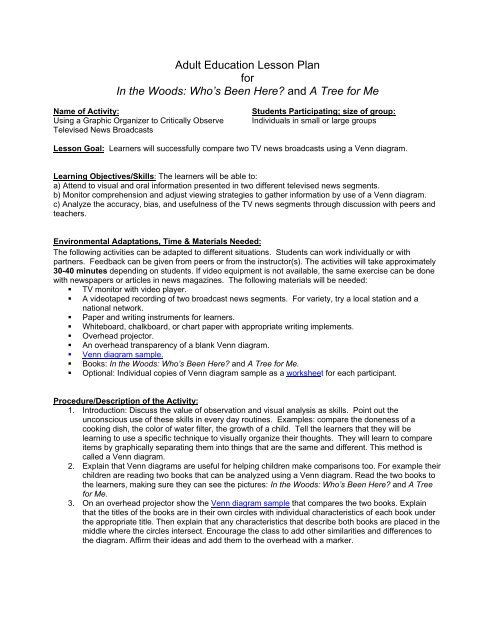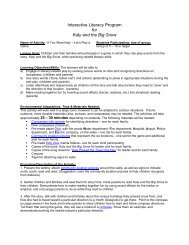Adult Education Lesson Plan
Adult Education Lesson Plan
Adult Education Lesson Plan
- No tags were found...
Create successful ePaper yourself
Turn your PDF publications into a flip-book with our unique Google optimized e-Paper software.
<strong>Adult</strong> <strong>Education</strong> <strong>Lesson</strong> <strong>Plan</strong><br />
for<br />
In the Woods: Who’s Been Here and A Tree for Me<br />
Name of Activity:<br />
Using a Graphic Organizer to Critically Observe<br />
Televised News Broadcasts<br />
Students Participating; size of group:<br />
Individuals in small or large groups<br />
<strong>Lesson</strong> Goal: Learners will successfully compare two TV news broadcasts using a Venn diagram.<br />
Learning Objectives/Skills: The learners will be able to:<br />
a) Attend to visual and oral information presented in two different televised news segments.<br />
b) Monitor comprehension and adjust viewing strategies to gather information by use of a Venn diagram.<br />
c) Analyze the accuracy, bias, and usefulness of the TV news segments through discussion with peers and<br />
teachers.<br />
Environmental Adaptations, Time & Materials Needed:<br />
The following activities can be adapted to different situations. Students can work individually or with<br />
partners. Feedback can be given from peers or from the instructor(s). The activities will take approximately<br />
30-40 minutes depending on students. If video equipment is not available, the same exercise can be done<br />
with newspapers or articles in news magazines. The following materials will be needed:<br />
• TV monitor with video player.<br />
• A videotaped recording of two broadcast news segments. For variety, try a local station and a<br />
national network.<br />
• Paper and writing instruments for learners.<br />
• Whiteboard, chalkboard, or chart paper with appropriate writing implements.<br />
• Overhead projector.<br />
• An overhead transparency of a blank Venn diagram.<br />
• Venn diagram sample.<br />
• Books: In the Woods: Who’s Been Here and A Tree for Me.<br />
• Optional: Individual copies of Venn diagram sample as a worksheet for each participant.<br />
Procedure/Description of the Activity:<br />
1. Introduction: Discuss the value of observation and visual analysis as skills. Point out the<br />
unconscious use of these skills in every day routines. Examples: compare the doneness of a<br />
cooking dish, the color of water filter, the growth of a child. Tell the learners that they will be<br />
learning to use a specific technique to visually organize their thoughts. They will learn to compare<br />
items by graphically separating them into things that are the same and different. This method is<br />
called a Venn diagram.<br />
2. Explain that Venn diagrams are useful for helping children make comparisons too. For example their<br />
children are reading two books that can be analyzed using a Venn diagram. Read the two books to<br />
the learners, making sure they can see the pictures: In the Woods: Who’s Been Here and A Tree<br />
for Me.<br />
3. On an overhead projector show the Venn diagram sample that compares the two books. Explain<br />
that the titles of the books are in their own circles with individual characteristics of each book under<br />
the appropriate title. Then explain that any characteristics that describe both books are placed in the<br />
middle where the circles intersect. Encourage the class to add other similarities and differences to<br />
the diagram. Affirm their ideas and add them to the overhead with a marker.
4. Explain that a Venn diagram can be used in comparing other kinds of information. For example we can<br />
analyze news sources using this technique. Show learners the two previously videotaped news segments<br />
on the same topic. Encourage note taking and other current language arts strategies for remembering<br />
information. If necessary view the video segments again in order for learners to gather enough details to<br />
analyze and discuss their observations.<br />
5. Guide the learners as they work in pairs to diagram the information from the news stories. Use questions<br />
regarding accuracy, bias, and usefulness of the information provided in order to prompt learner analysis of<br />
the content. For example: “Are the facts in both news stories the same If not what are the differences”<br />
While learners are working on this activity, affirm vocabulary words that clearly distinguish similarities and<br />
differences. Instructors can also review and reinforce current language arts goals such as separating the<br />
main point from supporting details in expository writing or recognizing persuasive language by asking<br />
questions like: “What was the point of view of the reporter How do you know”<br />
6. Then ask pairs to report the findings from their small group work. As they report, create a class Venn<br />
diagram on board or overhead. Provide guidance to keep the Venn diagram categories clearly distinct from<br />
one another. Continue to praise learners for focusing on characteristics that are alike and those that are<br />
different.<br />
7. Wrap-up: Discuss how separating information in this fashion helps us organize thoughts and make<br />
decisions. Ask what new ideas occurred after viewing and sorting the information. Discuss how this activity<br />
might influence the learners as they seek news information in the future. Praise the learners for their ideas<br />
and accomplishments. Discuss other situations in which a Venn diagram might be useful. Suggest that<br />
parents use this Venn diagram technique with their children after reading books on similar topics such as In<br />
the Woods: Who’s Been Here and A Tree for Me.<br />
Resources:<br />
George, Lindsay Barrett. In the Woods: Who’s Been Here Greenwillow: New York, 1995.
Assessment:<br />
For Informal Assessment<br />
Objective Participant’s Names Comments<br />
a) Attends to visual<br />
and oral information<br />
in two different TV<br />
news segments.<br />
b) Uses Venn<br />
Diagram approach to<br />
monitor and adjust<br />
viewing strategies.<br />
c) Analyzes the<br />
accuracy, bias, and<br />
usefulness of the TV<br />
news segments<br />
through discussion<br />
with peers and<br />
teachers.<br />
Reflect on the Activity:<br />
1. What worked well<br />
2. What didn’t work<br />
3. What might have made the activity more successful<br />
4. Did you notice any potential for follow-up activities based on what the students said or did<br />
Transfer Home/Extension Ideas: Compare the labels of two brands of a commonly purchased item<br />
(e.g.,cereal or a cleaning product) in a Venn Diagram in order to determine which brand better serves the<br />
family’s needs.<br />
Visually compare a child’s photographs from infancy to toddlerhood, or toddlerhood to preschooler. Discuss<br />
how organizing this information graphically helps to describe where their child is developmentally.<br />
Literacy Area(s)* Addressed (check all that apply):<br />
x The Power and Pleasure of Literacy x The Literate Environment Language Development<br />
Phonological Awareness Phonemic Awareness Types of Text<br />
Letters and Words Vocabulary Knowledge of Print<br />
x Building Knowledge & Comprehension Reading Comprehension Motivation<br />
Fluency<br />
x Multiple Literacy
















